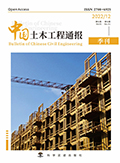

由于地质条件的限制及地下空间的综合开发利用, 地下工程有时不可避免地产生近距离交叉, 而盾构下穿综合管廊是此类工程问题中常见的问题之一。因此, 本文采用FLAC3D对盾构下穿地下综合管廊开展了开挖过程中管廊位移及地层沉降分析。结果表明整个盾构过程, 位移及应力最大的位置均在Z方向上 (竖直方向) 。在位移变化上, Z方向不同区域存在隆起和下沉两种位移形态, 部分区域最大可达到3. 34mm和2. 76mm, 而在X和Y方向上的位移均在0. 5mm左右。在应力变化上Z方向最大应力为2. 0MPa, 而X和Y方向上最大应力为0. 25MPa和0. 5MPa, 应力集中系数分别为1和2左右。在截污管道下穿综合管廊过程, 风险区域主要包括上部顶板中部, 两舱室底板和隔墙四个区域。上部顶板下沉量最大在管廊交叉影响范围中部 (X=47m) 位置, 管廊右舱和左舱底板隆起量最大处在交叉影响范围后部 (X=51m) , 且左舱隆起量大于右舱。管廊应力集中区域在两舱室隔墙处在交叉影响范围前部位置 (X=43m) , 因此, 在实际盾构过程中要对该区域重点监测其位移及应力的变化, 必要时应采取切底和加强支护措施, 以保持管廊结构稳定。
Due to the limitation of geological conditions and comprehensive development and utilization of underground space, underground engineering sometimes inevitably involves close spatial intersection, with shield tunneling beneath utility tunnels being a common challenge in such engineering projects. This study utilizes the numerical simulation software FLAC3D to analyze the displacement of the pipe corridor and the ground settlement during shield tunneling beneath an underground utility tunnel. The results indicate that during the entire shield tunneling process, the peak values of displacement and stress occur in the Z direction ( vertical direction) . In terms of displacement changes, the Z direction exhibits two types of displacement patterns: uplift and settlement. The maximum displacement in certain regions reaches 3. 34 mm and 2. 76 mm, while the displacement in the X and Y directions remains about 0. 5 mm. In terms of stress changes, the maximum stress in the Z direction is 2. 0 MPa, while in the X and Y directions, the maximum stress is 0. 25 MPa and 0. 5 MPa, respectively, with the stress concentration coefficient of approximately 1 and 2. During the process of sewage interception pipeline crossing the utility tunnel, the key risk areas mainly include the central part of the upper slab, the bottoms of the two compartments, and the partition walls. The maximum subsidence of the upper slab is in the middle of the pipe trench intersection influence range (X = 47 m) , and the maximum uplift of the right and left compartment bottoms is in the rear of the intersection influence range (X = 51 m) , and the left compartment uplift is greater than the right compartment. The stress concentration area of the pipe trench is in the front part of the partition walls in the intersection influence range (X = 43 m) . To ensure the structural integrity of the utility tunnel, it is necessary to monitor the displacement and stress changes in this area during the actual shield tunneling process and adopt foundation cutting and reinforcement measures when necessary.